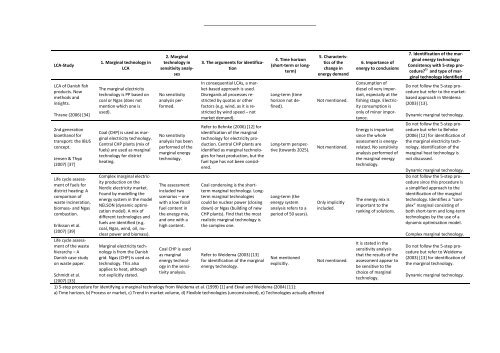Fuel cells and electrolysers in future energy systems - VBN
Fuel cells and electrolysers in future energy systems - VBN
Fuel cells and electrolysers in future energy systems - VBN
Create successful ePaper yourself
Turn your PDF publications into a flip-book with our unique Google optimized e-Paper software.
LCA‐Study<br />
LCA of Danish fish<br />
products. New<br />
methods <strong>and</strong><br />
<strong>in</strong>sights.<br />
Thrane (2006) [34]<br />
2nd generation<br />
bioethanol for<br />
transport: the IBUS<br />
concept.<br />
Jensen & Thyø<br />
(2007) [37]<br />
Life cycle assess‐<br />
ment of fuels for<br />
district heat<strong>in</strong>g: A<br />
comparison of<br />
waste <strong>in</strong>c<strong>in</strong>eration,<br />
biomass‐ <strong>and</strong> Ngas<br />
combustion.<br />
Eriksson et al.<br />
(2007) [39]<br />
Life cycle assess‐<br />
ment of the waste<br />
hierarchy – A<br />
Danish case study<br />
on waste paper.<br />
1. Marg<strong>in</strong>al technology <strong>in</strong><br />
LCA<br />
The marg<strong>in</strong>al electricity<br />
technology is PP based on<br />
coal or Ngas (does not<br />
mention which one is<br />
used).<br />
Coal (CHP) is used as mar‐<br />
g<strong>in</strong>al electricity technology.<br />
Central CHP plants (mix of<br />
fuels) are used as marg<strong>in</strong>al<br />
technology for district<br />
heat<strong>in</strong>g.<br />
Complex marg<strong>in</strong>al electric‐<br />
ity production on the<br />
Nordic electricity market.<br />
Found by modell<strong>in</strong>g the<br />
<strong>energy</strong> system <strong>in</strong> the model<br />
NELSON (dynamic optimi‐<br />
zation model). A mix of<br />
different technologies <strong>and</strong><br />
fuels are identified (e.g.<br />
coal, Ngas, w<strong>in</strong>d, oil, nu‐<br />
clear power <strong>and</strong> biomass).<br />
Marg<strong>in</strong>al electricity tech‐<br />
nology is from the Danish<br />
grid. Ngas (CHP) is used as<br />
technology. This also<br />
applies to heat, although<br />
not explicitly stated.<br />
2. Marg<strong>in</strong>al<br />
technology <strong>in</strong><br />
sensitivity analy‐<br />
ses<br />
No sensitivity<br />
analysis per‐<br />
formed.<br />
No sensitivity<br />
analysis has been<br />
performed of the<br />
marg<strong>in</strong>al <strong>energy</strong><br />
technology.<br />
The assessment<br />
<strong>in</strong>cluded two<br />
scenarios – one<br />
with a low fossil<br />
fuel content <strong>in</strong><br />
the <strong>energy</strong> mix,<br />
<strong>and</strong> one with a<br />
high content.<br />
Coal CHP is used<br />
as marg<strong>in</strong>al<br />
<strong>energy</strong> technol‐<br />
ogy <strong>in</strong> the sensi‐<br />
tivity analysis.<br />
3. The arguments for identifica‐<br />
tion<br />
In consequential LCAs, a mar‐<br />
ket‐based approach is used.<br />
Disregards all processes re‐<br />
stricted by quotas or other<br />
factors (e.g. w<strong>in</strong>d, as it is re‐<br />
stricted by w<strong>in</strong>d speed – not<br />
market dem<strong>and</strong>).<br />
Refer to Behnke (2006) [12] for<br />
identification of the marg<strong>in</strong>al<br />
technology for electricity pro‐<br />
duction. Central CHP plants are<br />
identified as marg<strong>in</strong>al technolo‐<br />
gies for heat production, but the<br />
fuel type has not been consid‐<br />
ered.<br />
Coal condens<strong>in</strong>g is the short‐<br />
term marg<strong>in</strong>al technology. Long‐<br />
term marg<strong>in</strong>al technologies<br />
could be nuclear power (clos<strong>in</strong>g<br />
down) or Ngas (build<strong>in</strong>g of new<br />
CHP plants). F<strong>in</strong>d that the most<br />
realistic marg<strong>in</strong>al technology is<br />
the complex one.<br />
Refer to Weidema (2003) [13]<br />
for identification of the marg<strong>in</strong>al<br />
<strong>energy</strong> technology.<br />
4. Time horizon<br />
(short‐term or long‐<br />
term)<br />
Long‐term (time<br />
horizon not de‐<br />
f<strong>in</strong>ed).<br />
Long‐term perspec‐<br />
tive (towards 2025).<br />
Long‐term (the<br />
<strong>energy</strong> system<br />
analysis refers to a<br />
period of 50 years).<br />
Not mentioned<br />
explicitly.<br />
Schmidt et al.<br />
(2007) [33]<br />
1) 5‐step procedure for identify<strong>in</strong>g a marg<strong>in</strong>al technology from Weidema et al. (1999) [1] <strong>and</strong> Ekval <strong>and</strong> Weidema (2004) [11]:<br />
a) Time horizon, b) Process or market, c) Trend <strong>in</strong> market volume, d) Flexible technologies (unconstra<strong>in</strong>ed), e) Technologies actually affected<br />
5. Characteris‐<br />
tics of the<br />
change <strong>in</strong><br />
<strong>energy</strong> dem<strong>and</strong><br />
Not mentioned.<br />
Not mentioned.<br />
Only implicitly<br />
<strong>in</strong>cluded.<br />
Not mentioned.<br />
6. Importance of<br />
<strong>energy</strong> to conclusions<br />
Consumption of<br />
diesel oil very impor‐<br />
tant, especially at the<br />
fish<strong>in</strong>g stage. Electric‐<br />
ity consumption is<br />
only of m<strong>in</strong>or impor‐<br />
tance.<br />
Energy is important<br />
s<strong>in</strong>ce the whole<br />
assessment is <strong>energy</strong>‐<br />
related. No sensitivity<br />
analysis performed of<br />
the marg<strong>in</strong>al <strong>energy</strong><br />
technology.<br />
The <strong>energy</strong> mix is<br />
important to the<br />
rank<strong>in</strong>g of solutions.<br />
It is stated <strong>in</strong> the<br />
sensitivity analysis<br />
that the results of the<br />
assessment appear to<br />
be sensitive to the<br />
choice of marg<strong>in</strong>al<br />
technology.<br />
7. Identification of the mar‐<br />
g<strong>in</strong>al <strong>energy</strong> technology:<br />
Consistency with 5‐step pro‐<br />
cedure? 1) <strong>and</strong> type of mar‐<br />
g<strong>in</strong>al technology identified<br />
Do not follow the 5‐step pro‐<br />
cedure but refer to the market‐<br />
based approach <strong>in</strong> Weidema<br />
(2003) [13].<br />
Dynamic marg<strong>in</strong>al technology.<br />
Do not follow the 5‐step pro‐<br />
cedure but refer to Behnke<br />
(2006) [12] for identification of<br />
the marg<strong>in</strong>al electricity tech‐<br />
nology. Identification of the<br />
marg<strong>in</strong>al heat technology is<br />
not discussed.<br />
Dynamic marg<strong>in</strong>al technology.<br />
Do not follow the 5‐step pro‐<br />
cedure s<strong>in</strong>ce this procedure is<br />
a simplified approach to the<br />
identification of the marg<strong>in</strong>al<br />
technology. Identifies a “com‐<br />
plex” marg<strong>in</strong>al consist<strong>in</strong>g of<br />
both short‐term <strong>and</strong> long‐term<br />
technologies by the use of a<br />
dynamic optimisation model.<br />
Complex marg<strong>in</strong>al technology.<br />
Do not follow the 5‐step pro‐<br />
cedure but refer to Weidema<br />
(2003) [13] for identification of<br />
the marg<strong>in</strong>al technology.<br />
Dynamic marg<strong>in</strong>al technology.

















